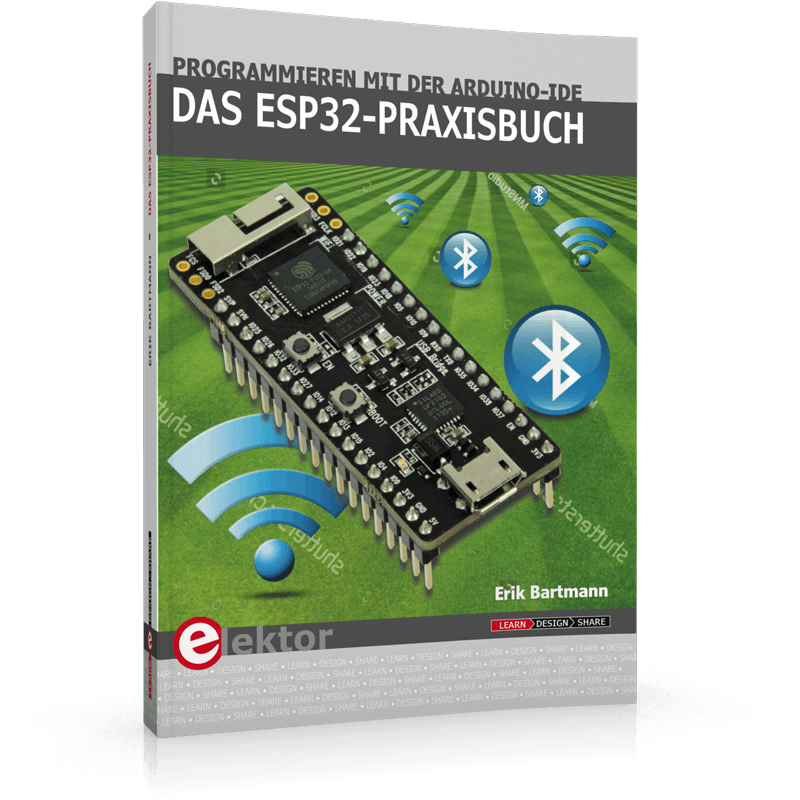- Home
- Hardware
- SDKs
- Cloud
- Solutions
- Support
- Ecosystem
- Company
- Contact
news
New Book on ESP32 by Best-Selling Author Erik Bartmann
Shanghai, China
Sep 30, 2018
Erik Bartmann has published a book on ESP32, "Das ESP32-Praxisbuch" (The ESP32 Practice Book), and has given us an interview about it.
Erik Bartmann is a seasoned programmer and maker from Germany. He is also a best-selling author who has written many books about programming and electronics. His books are always highly successful across the German-speaking countries in Europe. In November 2016 he published, with Elektror-Verlag, Das ESP8266-Praxisbuch: Mit NodeMCU und ESPlorer (The ESP8266 Practice Book: With NodeMCU and ESPlorer). In an interview he gave us shortly afterwards, he said he also wanted to write a book about ESP32. And he certainly kept his word! In Das ESP32-Praxisbuch (The ESP32 Practice Book), Erik Bartmann explains readers in a lucid and engaging manner the great variety of projects they can bring to life with Espressif’s flagship System-on-a-Chip.

ESP: Hi Erik, the last time we spoke was about your ESP8266 Praxisbuch, which proved to be hugely popular with the international maker community. A little over a year later you released your ESP32 Praxisbuch. Can you please describe the main objective of your new book?
EB: My new book about ESP32 shows that the Wi-Fi module is an integral part of the modern Maker toolbox. I show how to control ESP32 with the Arduino IDE. This tool is known to every maker, so teaching how to work with it is easy. In the book I also show the construction of a hardware development environment, my ESP32 Discovery Board. This board, which every reader can easily build by themselves, makes it possible to carry out many electronics-related projects with ESP32, without having to constantly rebuild breadboards. The didactic benefit is very high.
ESP: As an expert in both ESP8266 and ESP32, how do you think the two chips compare with one another?
EB: Both chips have sophisticated electronic components. Of course, ESP32 also has the exciting aspect of "Bluetooth". It is interesting to note, however, that ESP8266 still has a firm place in the electronics world.
ESP: Since the release of ESP32 in 2016, there have been several books about Espressif’s flagship SoC. Can you tell us more about the specific vantage point from which you talk about ESP32 in your book and how this makes your book unique?
EB: I think that my book is unique from a didactic point of view: I combine knowledge about the ESP module with basic electronics and coding topics. My books always focus on specific projects that build on each other in terms of their complexity, but, where necessary, I also impart knowledge that readers can take with them forever. In my ESP32 book, for example, I also delve into topics, such as MQTT, Bluetooth basics, the JSON format, and so on.
ESP: Should the readers of your book be experts in IoT technology to grasp its content?
EB: No. The reader of my ESP32 book must be curious and have the desire to realize their own ideas with the help of electronics. I share basic knowledge where it's needed. The reader learns from the book by copying the projects. These projects are based on a didactic approach: from temperature measurement to setting up database systems. In addition, I also make a slight digression about the Python programming language and how it can be used for controlling ESP32.
ESP: What do you think are the three most important features of ESP32?
EB: Bluetooth functionality, richness of interfaces, continuous enhancement. And cheap!
ESP: To what extent do you think ESP32 can be considered a catalyst of change in the Internet of Things?
EB: ESP32 is the “missing link” between the real world and the digital world. This is the role ESP32 plays for the IoT. Of course, there were Wi-Fi modules before ESP32, but Espressif was lucky to have the right timing, when launching this module on the global market. Right timing combined with the proven tools of the open-source DIY world and continuous firmware maintenance are the success factors that distinguish the ESP32 module from other Wi-Fi modules.
ESP: Are there any improvements you would like to see on ESP32 in the near future?
EB: I would be very happy if the Espressif tools for programming the ESP32 module would be further improved. I would also be very happy if ESP32 could also be controlled in the future with such programming languages as Scratch 3. Access to ESP32 should be as varied as possible.
ESP: How easy is it for you to combine book writing with all the other engagements you have in your daily professional life?
EB: Writing books is a great passion of mine. When I am intrigued by a certain subject, it feels like embarking on a great journey. I often don't know where it will take me, but, like in real life, the journey itself is the goal. Often I am only a few months ahead of the reader in my knowledge, discovering many topics only while writing the book. But that helps me to ask the same questions my readers would ask themselves. For me, writing books is a special form of acquiring new knowledge. I can then use this knowledge for my other work as well.
ESP: Would you like to share with us any news about the projects you are currently working on? And what should we expect from you in the future?
EB: I'm currently working on hardware boards. I developed a discovery board for the ESP32 book, where the ESP32 Pico board is the base. Now, I am developing an ESP32 Discovery Board based on the ESP32 DevKit C.
Then, I am very interested in FPGA programming. There is a new board from Arduino, the "Arduino MKR Vidor 4000", and I’m flirting with the idea of writing a book about it. I also find Scratch 3 very interesting. And next year I'll be revising my Arduino bestseller; so much has happened in the Arduino world over the past 2 years! There's a lot to explain!
ESP: Many thanks for answering all of our questions, Erik. We hope your ESP32 Praxisbuch is even more successful than your previous books.
EB: Thank you for this interview. I really appreciate that Espressif is so close to makers all over the world, listening carefully to them and taking note of their needs.


 LinkedIn
LinkedIn 微信
微信
 Twitter
Twitter Facebook
Facebook
